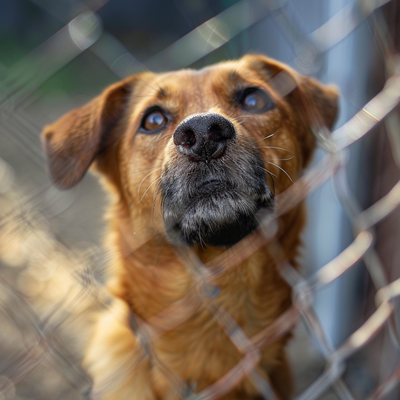How to Leash Train Your Puppy [Dog Trainer Explains]
You might wonder why it’s so difficult for puppies to learn how to walk politely on a leash. After all, it’s as simple as matching our pace. But loose leash walking is directly opposite to a dog’s instincts. Dogs want to run, while we may want to stroll. Dogs want to inspect every shrub and fire hydrant, while we stick to the sidewalk. And also, they want to follow their noses, not follow our lead. So, it takes time and patience to teach a puppy good leash manners. But it’s well worth the effort. Let’s look at how to successfully leash train your puppy.

At What Age Can You Start Leash Training a Puppy?
Can puppies be leash trained? Of course, they can. You might ask, “How soon should I put my puppy on a leash?” The answer is right away. You need to get your puppy outside for exercise, mental stimulation, and socialization, and having your puppy on a leash is the safest way to do that.
But don’t just clip on a leash and take off down the sidewalk. That’s sure to develop bad habits like pulling. Although a puppy might not drag you too far, a grown bully breed is sure to win that contest. Instead, teach your puppy to equate their leash with polite walking behavior. The lessons should start as soon as you get your puppy home.
How Do I Train My Puppy Not to Pull On The Leash?
Wearing a collar and having a leash trailing behind them feels odd to a dog. So, let your puppy get used to them inside your home before you ever venture outside on a walk. Start by letting your puppy wear their collar and leash in the house for short periods of time – 5 to 10 minutes. While the leash is on, play games with your puppy and offer delicious treats or other rewards. You want your puppy to look forward to wearing their leash and to associate it with good things coming directly from you.
Next, encourage your puppy to follow you around while they are clipped to their leash. Simply walk back a few paces and call them to you. You can use their name, pat your legs, or make kissy noises. Whatever entices them to follow. Then reward your puppy when they catch up. Continue training until your puppy will walk a few paces with you. But keep your sessions short. End while your puppy is still eager to follow rather than waiting until they’ve lost interest in the game.
Now that your puppy associates the leash with the follow-me game, hold the leash in your hand and build distance. Try walking up and down the hall or around the living room. Reward every few steps at first and place the treat at your side. You want your puppy to believe the area next to your legs is a great place to hang out. Also, don’t forget to enthusiastically praise your puppy for following you. You want them to think this is a fun activity instead of feeling like you’ve taken them away from something better.
What Is The #1 Trick To Stop Your Dog From Pulling On The Leash?
Once your puppy will walk politely on leash in the house, it’s time to take them outside. If you have a backyard, start there. The front of the house will be distracting with cars, bikes, people, and more. If you can limit at least some of the distractions, your puppy will have a better chance at success. Repeat the follow-me game you played in the house but expect your puppy’s performance to drop. You’re competing with a lot of exciting sights and smells now. That means you need to be patient and provide rewards for less. For example, if your puppy could walk 8 steps in the house before getting a treat, you might get 2 outside. That’s okay. Stay positive and engaging and keep those rewards flowing.
But what do you do if your puppy starts to pull on the leash? They might see a squirrel or catch an interesting scent and off they go. The number one trick to handle pulling behavior is to stand still. Pulling should never pay off. If you let your puppy drag you towards their goal, you are rewarding the pulling behavior. So, it will happen again in the future. Instead, plant your feet and wait. Eventually, your puppy will come back to see what’s holding you up. As soon as there is slack in the leash, praise your puppy, offer a reward at your side, then start walking again.
In the beginning, you might need to encourage your dog to return to you. But as long as you’re consistent – a tight leash means no walking and a slack leash means you can go – your dog will learn. It helps to be unpredictable. Make surprise turns while encouraging your puppy to follow you. If they never know where you’re going next, they will be more interested in paying attention to you. Also, talk to your puppy and be exciting. If you sound like you’re where the party is, the surrounding distractions won’t be as hard for your puppy to resist.
How Do I Stop My 6-Month-Old Puppy From Pulling On The Lead?
Now that your puppy is walking nicely, you might think that good behavior is set for life. But just wait for the teenage months. That’s when hormones start flowing.
The distractions your puppy was able to ignore become a magnet for your six-month-old dog. Don’t give up if you notice your teenage dog’s performance backsliding. Return to basics on leash-training your puppy and reward more frequently.
Maybe your puppy used to go two houses without pulling. Now it might be three sidewalk tiles. Lower your expectations, stay upbeat, and talk to your dog to keep their interest. And most of all, remain firm with the no-pull rule.
Too often people let their dog pull because they’re in a rush. They think it’s only once, what harm can it do. But every time you allow your dog to walk when they pull, they learn it gets them what they want. And you’ve set your training back to the beginning.
How Do You Punish a Dog For Pulling On The Leash?
No doubt you’ve seen people walking their dogs and having a tug of war through the leash. The dog pulls them, and they pull back. And you’ve probably seen that same person suffering that frustration for years. This begs the question, can I yank my dog on a leash? No. Using the leash to pull or drag your dog is simply ineffective. The leash is about safety, not control. If you pull on your dog, they will pull back. It’s an instinct. You are also going to frustrate your dog because you aren’t providing any guidance on what they should be doing instead. How can you expect your dog to keep the leash slack if you don’t.
So, how do you punish your dog for pulling on the leash? You don’t. Your dog is only pulling because excitement got the better of them. They aren’t trying to dominate or control you – they just want to get moving. All it takes is stopping the walk to remind them of the rules. Stand still until they return to you, letting the leash fall slack. Then praise and reward them by starting the walk again. Technically, psychologists and dog trainers call this negative punishment. You’ve taken away what the dog wants, to walk, to reduce their pulling behavior. But you aren’t doing anything aversive or negative to your dog. Positive punishment, doing something your dog doesn’t enjoy like a swat on the rump, isn’t necessary or useful. It doesn’t teach your dog what to do instead and erodes the dog-owner bond.
How Long Does It Take To Train a Dog Not To Pull?
If you’re wondering, how do I stop my dog from pulling in five minutes, then you’re asking for disappointment. This isn’t a quick fix. In the beginning, your walks might be short yet time consuming. For example, it might take you 10 minutes to get to the house next door. After all, there are many things in the neighborhood competing for your dog’s attention. But if you stick to the no-pull rule and heavily reward polite walking behavior, your puppy will learn what’s expected. And the effort is worth it. The last thing you want is a powerful adult dog dragging you down the street. It’s embarrassing, frustrating, and dangerous.
Stick to the above techniques and make sure your dog thinks it’s worthwhile to follow your lead. If you do, your dog will be far more likely to walk close to you than to pull you down the sidewalk. And once your dog has mastered loose leash walking, your walks will be far more pleasant. You can both enjoy getting outside for physical exercise, mental stimulation, and socializing with the neighbors.
Have you tried leash training your puppy? What challenges did you face, and how did you overcome them? Share your experiences and tips in the comments below to help fellow dog owners on their leash training journey!






![How to Train a Search and Rescue Dog [Dog Trainer Explains]](http://shop.bullymax.com/cdn/shop/articles/Search_and_Rescue_Dogs_in_dog_training_court.jpg?v=1713867590&width=400)

